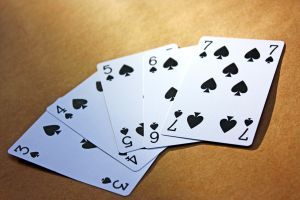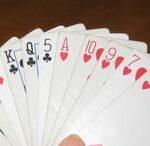This guide was written for strategy. It won’t teach you how to play Spades. You already have to know and understand the rules. But, it will teach you how to play the game better. Many people will say, “I didn’t get good cards”. However, unlike most card games, you don’t need good cards to win. The game of spades is nearly 100% strategy. This is why I love the game so much.
Bidding – This is the most important aspect of the game. Once you learn how to bid strategically, you’ll become a master. What you bid will depend on several factors. Take the following into consideration before placing your bid.
How many can you take easily? Many people believe they need to be dealt high cards and lots of spades in order to win. This is not true. Look at your hand and decide how many you can easily take without struggling. The worst thing that can happen is being set back. This can take several hands to make up for.
How many bags do you have? If you don’t have a lot of bags, you want to bid on the safe side. Most of the time, I am bidding one less and I’m almost never set. Once you get your bid, you can always start throwing off your cards. Bidding one less is also a great strategy in case your partner seems to be struggling taking their tricks. It will allow you to jump in and cover them. This gets harder if you already have a lot of bags and are in danger of being bagged back. In this case, rather than bidding one less, you want to bid exactly how much you believe you can take. No more. No less.
How many bags do your opponents have? If your opponents are in danger of being bagged back, it’s a great idea to underbid and force them to take tricks they may not want. I’ve been known to bid 2 on a hand I could actually take 5 with. I play the hand like I am nil and force the other team to take 3 extra tricks and bagging them back 100 points. Again, look at your cards because it could backfire and you could be forced to actually take a bunch of bags if you’re not careful.
What has already been bid? I love been in the last bidding position. There are only 13 tricks available to take. So, if I think I have 4 but the total of the bids is 10, I have to make a decision. If I bid the 4, one team is getting set back. I don’t want it to be my team. So, is my hand really strong enough to take 4 tricks? Did my partner overbid?
On the flipside, if I think I have 4 but the total of the tricks bid so far is 7, that leaves 2 on the table. If someone has bid nil, they’re going to be throwing off. This may mean that I actually will be forced to take one more. So, I may actually end up bidding 5 instead of 4. A lot of times, there is that one card that you think may or may not become a trick. If the bid total is low, you should probably consider counting that as a trick.
What’s the score? If it is toward the end of the game, consider who is closest to winning. If you’re way behind, you need to figure out a way to prevent your opponents from gathering the amount of points they need to win in that round. It could be by setting their bid. It could be by bagging them back. In this case, you are not bidding your hand. You are bidding the score. Think of what situation needs to happen in order to prevent that last round from allowing your opponents to win the game and bid accordingly.
Also, if you are in winning position and your opponents are far behind, you need to bid conservatively. The worst thing that can happen is being set back on a bid that would have otherwise won the game for you. The potential last round when you are in winning position is not a great time to bid nil
Nil – I only suggest going nil if you are an experienced player and trust your partner. When your partner is nil, you need to bid your hand and maybe one additional. Your opponents just might lead low to try to set your partner’s bid and you will have to have the cards to prevent getting set. Pay attention to what cards your partner has thrown. If you lead with the Ace of Diamonds and they throw a 10, you know that they don’t have any cards higher than that. So, the next time around, it would be safe to throw a 9. Save some spades for the last few rounds.
When the other team goes nil and you get to bid after they bid the nil, it’s a great opportunity for you to bid your hand to set them. When the other team is nil, you should never lead high. This doesn’t mean you shouldn’t take tricks. But, you should refrain from throwing high cards until after the nil player has thrown a card. For example, if you are last to throw and the first player has thrown a Jack, the second player (your partner) should throw no higher than the Queen. This will force the nil player in third position to keep the King or Ace in their hand if they have it. They will need to throw a 10 or lower. At this point, if you have the King or Ace you should throw it. This way, you will have less high cards in your hand. Don’t expect a nil to be busted right away. It’s usually busted within the last three throws. In the previous example, if the nil player has the King and their partner doesn’t have the Ace, it’s easy to figure that out. Queen is out, Jack is out. Obviously, position one (who will be covering the nil) doesn’t have the Ace or they would’ve thrown it to cover their partner. Your partner may have it, but they throw the Queen. If you have only the Ace, it’s a possibility that the nil player has the King. So, you should throw your King and take the trick. Now, it’s your turn to throw. Staying in the same suit, throw a low card and try to force out their King. Hopefully, their partner won’t cut with a spade. But, even if they do it’s fine because that just means there’s less spades out there to cover the nil player. So, to bust a nil, you and your partner have to be on the same page in terms of not allowing the nil player to throw under you. Hence, their partner must have high cards to cover them.
Game Play – It’s important to keep track of how many tricks you have taken during a round. You need to know how many more tricks you need or do not need. Obviously, if you are close to bagging back, your opponents (if they are good players) will try to give you bags. Keep this in mind while bidding and during the course of the round. I try to get rid of medium cards first, this will end up giving me an option toward the end of the round if I want to take a trick or not depending on what has already happened. If I need it, I throw my high card. If I notice the other team is deliberately throwing low, I can throw under.
Pay attention to what cards your partner has. After a few tricks, you’ll be able to tell what kinds of cards they have left and go from there. If the bid is locked (that means the total of the tricks bid is 13) you really need to take every trick you bid plus one more to set the other team. So, pay attention to what your partner has. During game play, nothing is worse when you have the Ace and your partner chimes in and tosses a spade forcing you to throw the Ace and stealing your trick. If they were paying attention, they would know you have it and throw off rather than wasting a spade. You can also feed tricks to your partner. For example, if they are out of Hearts, you want to throw a Heart so they can toss their spade and take the trick if you need it.
Put yourself in the opponent’s place and think of what you would bid if you were on the other team given the score and take that into consideration for bidding and during play. If you have a lot of bags, you know the other team will bid slightly lower to force tricks into you. So, be aware of that. If the bid is locked, you know the other team will try to take an additional trick. It’s worth taking a bag to set the other team. Realize this is well.
Your strategy may also change throughout the course of the round. You may have bid low with the intention of bagging the other team. But, if the total bid is 12 or 13 when everyone is done and you know you can take extra, you may just change your strategy to not throw off and take tricks to set the other team. Then, during the course of the round that may not be working. Tricks you have tried to take haven’t worked out. So, you may change your strategy again to give the opponents the extra bag or two. You have to constantly be thinking and be aware of what has happened and figure out the possibility of who has what cards left in their hand by using the process of elimination.
Remember, Spades is a game you need to work with a partner with. If you’re only concerned about what your personal bid is and playing your hand, you’re going to lose the game. Work with your partner. Analyze what cards they have left. Work with your partner after bidding to help each other reach that goal.


